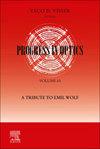Coupled Plasmon Wave Dynamics beyond Anomalous Reflection: A Phase Gradient Copper Metasurface for the Visible to Near-Infrared Spectrum
3区 物理与天体物理
Q1 Materials Science
引用次数: 1
Abstract
In nanoscale photonic devices, the demand for multifunctionality from 2D metasurface optics has increased rapidly. To explore the required fine-tuning in the design metrics, we reinvestigated the trapezoid-shape copper metasurface using finite-difference time-domain simulation to efficiently utilize linearly polarized light for two different functionalities. From the plasmonic band structure, we could see how the degree of asymmetry in the geometry affected the efficient resonance coupling of the traveling plasmonic modes, along with the different types of mode hybridization profiles that were related to the nanoantenna’s geometric shape. By tuning the nanoantenna’s length, we could excite the effective plasmon mode that was supported by this configuration and guide surface waves unidirectionally from the normal incidence free-space light within the visible to infrared range. The directed surface plasmon polaritons had both antisymmetric and symmetric modes that oscillated between the top and bottom surfaces of the continuous metal layer, depending on the nanoantenna’s length and wavelength. This proposed copper metasurface was optimized for a far-field application of broadband (600–900 nm) anomalous beam steering for an average of 60% efficiency with a maximum angle of 64°. This work offers more understanding of a metasurface being implemented in small plasmonic devices, waveguide mode controlling and beam steering with wavelength-dependent functionalities.超越异常反射的耦合等离子体波动力学:可见到近红外光谱的相位梯度铜超表面
在纳米级光子器件中,二维超表面光学对多功能性的需求迅速增加。为了探索设计指标中所需的微调,我们使用有限差分时域模拟重新研究了梯形铜超表面,以有效地利用线偏振光实现两种不同的功能。从等离子体带结构中,我们可以看到几何上的不对称程度如何影响行等离子体模式的有效共振耦合,以及与纳米天线几何形状相关的不同类型的模式杂交谱。通过调整纳米天线的长度,我们可以激发这种结构所支持的有效等离子体模式,并在可见光到红外范围内单向引导正入射自由空间光的表面波。根据纳米天线的长度和波长,定向表面等离子激元具有在连续金属层的上下表面之间振荡的反对称和对称模式。该铜超表面针对宽带远场应用(600-900 nm)异常光束转向进行了优化,平均效率为60%,最大角度为64°。这项工作提供了更多的理解在小型等离子体器件中实现的超表面,波导模式控制和具有波长相关功能的光束转向。
本文章由计算机程序翻译,如有差异,请以英文原文为准。
求助全文
约1分钟内获得全文
求助全文

 求助内容:
求助内容: 应助结果提醒方式:
应助结果提醒方式:


